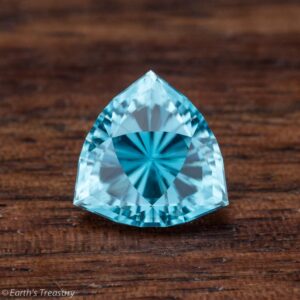Zircon

Overview
Zircon is still not very well known by many, even though it’s been used as a gemstone since antiquity. The name is generally believed to have been derived from the Persian “zargun,” which means golden-colored. With good hardness, excellent brilliance and fire, zircon deserves to be more popular than it is–and indeed the popularity and prices of fine zircons have risen substantially in recent years. While it comes in a wide variety of colors, the most popular is a deep blue-green often referred to as “Caribbean Blue,” a reference to the similarity to the color of the waters of the Caribbean Sea.
Zircon should not be confused with the manmade gem cubic zirconia. It is a natural gemstone and has different properties than the manmade gemstone.
Named Species/Varieties
Zircons come in two major types: High and Low. Low zircons have been transformed over the millennia due to natural radioactivity in the gems. This slightly reduces the refractive index and hardness of the gems, but also results in some of the unique colors, such as the beautiful lime green zircons. The exact type is not often described as it is of little importance to its use as a gemstone, and is more of a gemological curiosity.
Where is it found
Zircon is ubiquitous in the earth’s crust. Indeed, some of the oldest known minerals are zircons, and they are used to help establish the age of the rocks found within the earth’s crust. Significant gem deposits are found in Africa (Tanzania, Nigeria, Madagascar), Asia (Sri Lanka, Burma, Cambodia and Viet Nam) as well as Australia.
Treatments
Zircons are often heated to change or lighten the color. Heating can turn brown zircons to various shades of yellow, orange or red. Some brown zircons can be changed to shades of blue when heated in a reducing environment to approximately 1000 C. These blues are some of the most prized zircons, and are mostly sourced from Cambodia and Nigeria. The treatment is permanent in most cases, although some zircons will gradually return to their original color. This happens fairly quickly so these zircons are generally not seen in the market, as better quality material is easily available.
Use in jewelry
Zircon is relatively common and has good hardness (7.5 on the Mohs scale), so its both widely available and well-suited for use in jewelry. It is a brittle stone, so care should be taken when its used in rings, as the facet edges can abrade. Colorless zircons have a brilliance and dispersion that allows them to rival diamonds; the refractive index ranges from 1.810-2.024 and the dispersion is approximately 0.039. High zircons are also notable for a relatively high birefringence, which can result in a doubling of the facets depending on how the gem is oriented when cut.
Buy Zircon
You can look at my current inventory of loose gemstones online here: https://earthstreasury.com/product-category/gemstones/zircon/

